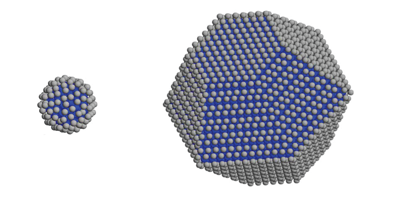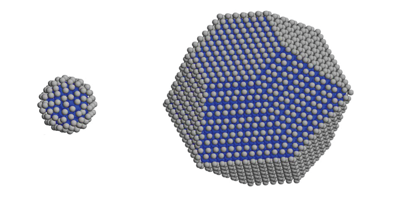Looking for Atoms that Pack By the Rules
Atoms pack most densely into a crystal when arranged like billiard balls in a pool rack, with the layers stacked one on top of the other. There are infinitely many ways to stack the layers, but the two most common stackings found in real crystals are the face-centered-cubic (fcc) structure, and a structure called hexagonal close packed (hcp). Calculations suggest a slight energetic preference for closed-shell atoms, like neon, argon or krypton, to solidify into the hcp structure, but in experiments, these atoms almost always solidify into the fcc structure. A new experimental study of argon nanoclusters reported in Physical Review Letters may point to a resolution of this long-standing problem. The experiments show argon can form the predicted hcp structure, provided small (few-atom) clusters form first, before fusing together to form larger ones.
Simulations that predict material structures do so by comparing the energies of different configurations of atoms. But in many growth techniques, it may not be the case that atoms can actually explore the lowest energy arrangement.
Nina Krainyukova, at the National Academy of Sciences of Ukraine, and colleagues ensured this happened by injecting a low concentration of argon into a superfluid helium bath, which allows the argon atoms to coalesce into small clusters that eventually interconnect in a large porous structure (the size of a die). As the structure warms, small argon clusters fuse into larger ones. Under these conditions, the authors observe with x-ray diffraction that clusters a few thousand atoms in size favor the fcc structure, but clusters with ten times as many atoms form the hcp structure. The gain in surface energy from two clusters fusing may be what allows them to reach the hcp structure, the most commonly predicted ground state for solid argon. – Jessica Thomas





